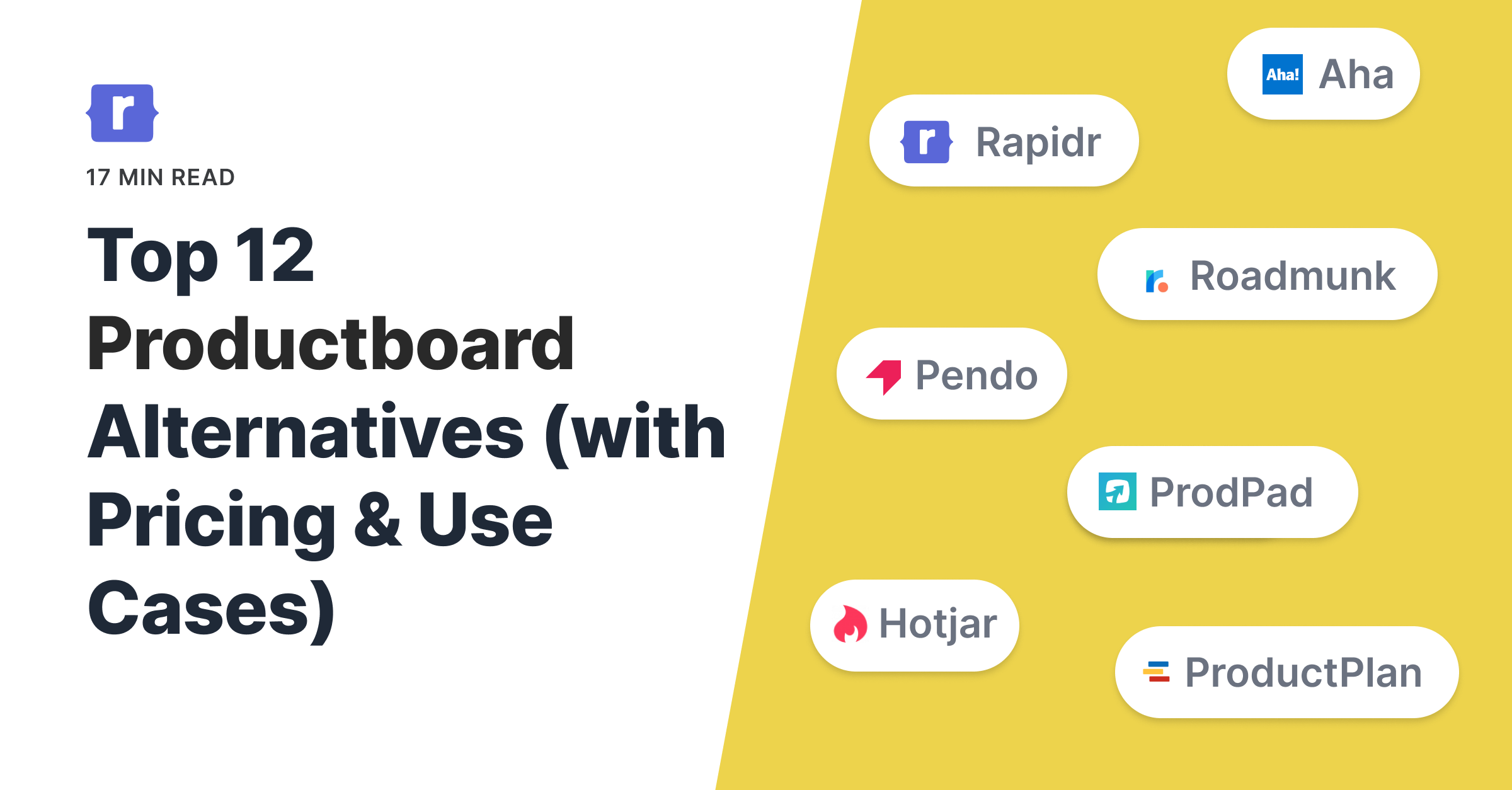
Top 12 Productboard Alternatives & Competitors For Product Management
Productboard is a digital product management platform that helps teams get the most out of their product development process.
Productboard is more focused on product roadmapping and provides a complicated user experience bloated with features, proving it to be a not-so-perfect product feedback solution for many.
If you are looking for a modern and user-friendly Productboard alternative, we've compiled a list of comparable, if not better, tools than Productboard. We recommend these 12 excellent product management and feedback tools with their pros and cons.
Top 12 Productboard Alternatives & Competitors For Product Managers
- Rapidr
- UserVoice
- ProductPlan
- Prodpad
- Airfocus
- Roadmunk
- Asana
- Jira
- Craft.io
- Clickup
- Monday.com
- Pendo
But first, let's look at Productboard features and capabilities, so we have a common yardstick to compare user feedback software in this list.
What is Productboard?
Productboard is a project management tool that helps product managers understand what customers need, prioritize what to build next, and rally everyone around the roadmap. It consolidates customer feedback into a prioritized roadmap based on data.
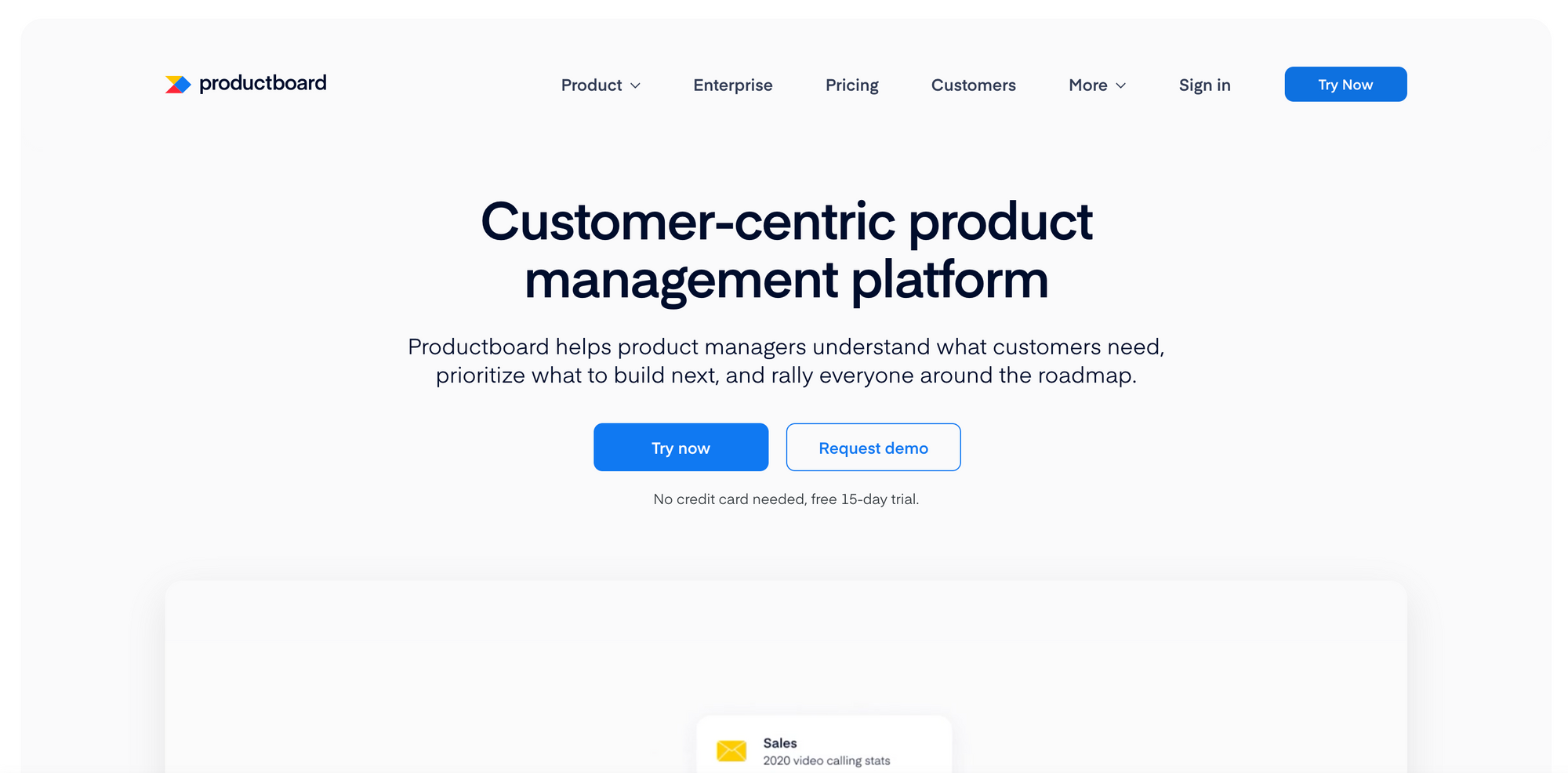
What is Productboard Used For?
Best for project management and roadmapping.
Rated: 4.3/5
Pros of Productboard
- Productboard is a project management tool that combines a product feedback voting board and inbox with prioritization methods and roadmaps.
- Key features include collecting product feedback from email, prioritizing features with a set of frameworks, various product roadmap templates, etc.
- Many integrations such as Slack, Zapier, and Salesforce are supported to manage projects and customer feedback.
Cons of Productboard
- Productboard feels like an overly complex project management tool, much less a feature-tracking tool. No doubt, it's great, consisting of all the customizations, but configuring the right setting for managing user feedback feels like a chore.
- As a user stated, "The primary method of capturing customer input (insights) does not link to the process of evaluating potential features in the features section, requiring this tracking to be performed manually. This limits the ability to tie development directly to user input".
- It is expensive. At the time of writing, prices start from $20 a month for one admin and five contributors with limited admin rights and restricted features compared to other customer feedback management tools.
Top 12 ProductBoard Alternatives & Competitors For Product Roadmapping
1. Rapidr
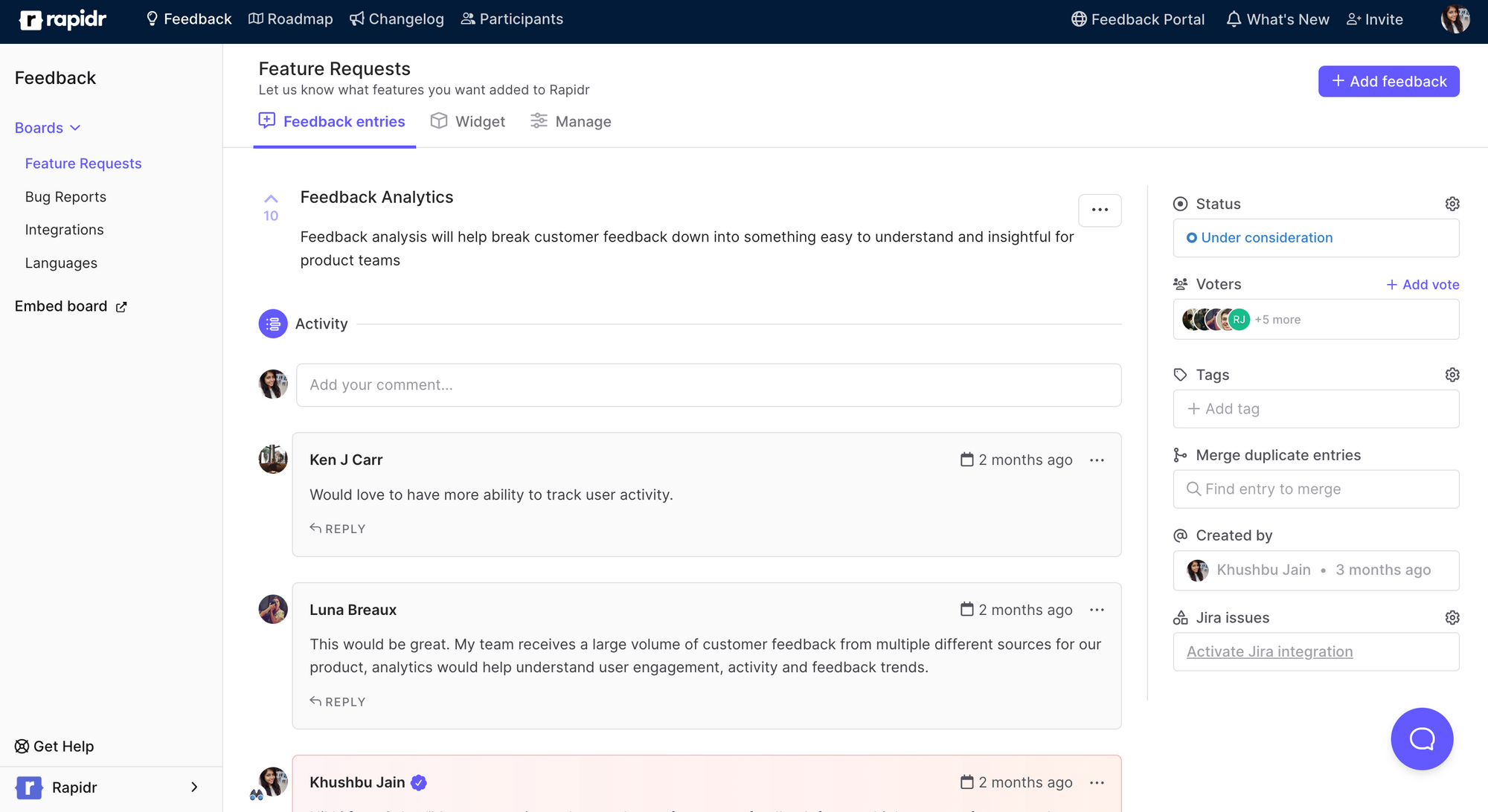
Rapidr helps product teams understand what customers need by tracking feature requests and ideas, analyzing & prioritizing what to build next, creating a roadmap backed by customer insights, and communicating new features with release notes.
Understanding customers begins by collecting their feedback in a centralized app. Rapidr helps you capture product ideas, requests, and feedback from colleagues and customers with their customer portal and in-app widget.
Next, for analyzing and prioritizing the roadmap based on customer insights, Rapidr helps you slice and dice feedback by customer attributes and sorting by votes.
Lastly, inform your roadmap with the most critical feedback, and let your customers know what's new with release notes.
Use Case: Best for product feedback and roadmapping.
Pros of Rapidr
- Rapidr is an end-to-end feedback solution, so you don't have to glue multiple apps together to close the feedback loop. By choosing Rapidr, you get feedback collection, roadmap software, and release notes software – all in one place.
- Rapidr is one of the most reasonable and cost-effective solutions that offer excellent value for money stacked against the other enterprise options on this list. Rapidr's pricing is based on the weight you derive from the software instead of per-seat pricing.
- Rapidr's hosted feedback portal and widgets are lightweight, easy to use, and customizable, fitting perfectly with your existing workflows and brand design.
- Rapidr's customer portal gives your users a persistent place to come and leave their ideas and requests. You can create multiple feature voting boards for every use-case or product vertical.
- Rapidr can be fully white-labeled on high-end plans. White-labeling removes the "Powered by Rapidr" link from your feedback portal and emails, which means no visible branding from Rapidr.
Cons of Rapidr
- Rapidr has a few integrations, including Jira, Slack, Intercom, and Zapier, at the time of writing, but many are on the way. They track integrations on their public feedback board.
- Rapidr is relatively new in the market, and many features are still being built. But with features rivaling Productboard at a reasonable pricing plan and in the hands of trusted people, it's an excellent option for anyone looking for a lean, simple, and clean product feedback alternative.
Reviewers say that compared to Productboard, Rapidr is:
The good parts:
- End-to-end feedback-focused solution
- Cost-effective and affordable. Plans start from $49/mo.
- Modern and lightweight interface.
- Easy to use.
- Brilliant Customer Support.
- Quick to set up and run.
The bad parts:
- Fewer integrations.
- SOC2 is not available.
Rapidr has changed the way we collect and manage feedback from our users. It helped us to create a single point of entry for all feedback requests across our product and avoid using huge spreadsheets and slack channels. It also helps keep our users and teammates in the loop as we make decisions for the product. - Daniel Wolken (Founder)
Read more: Compare Productboard vs Rapidr.
2. UserVoice
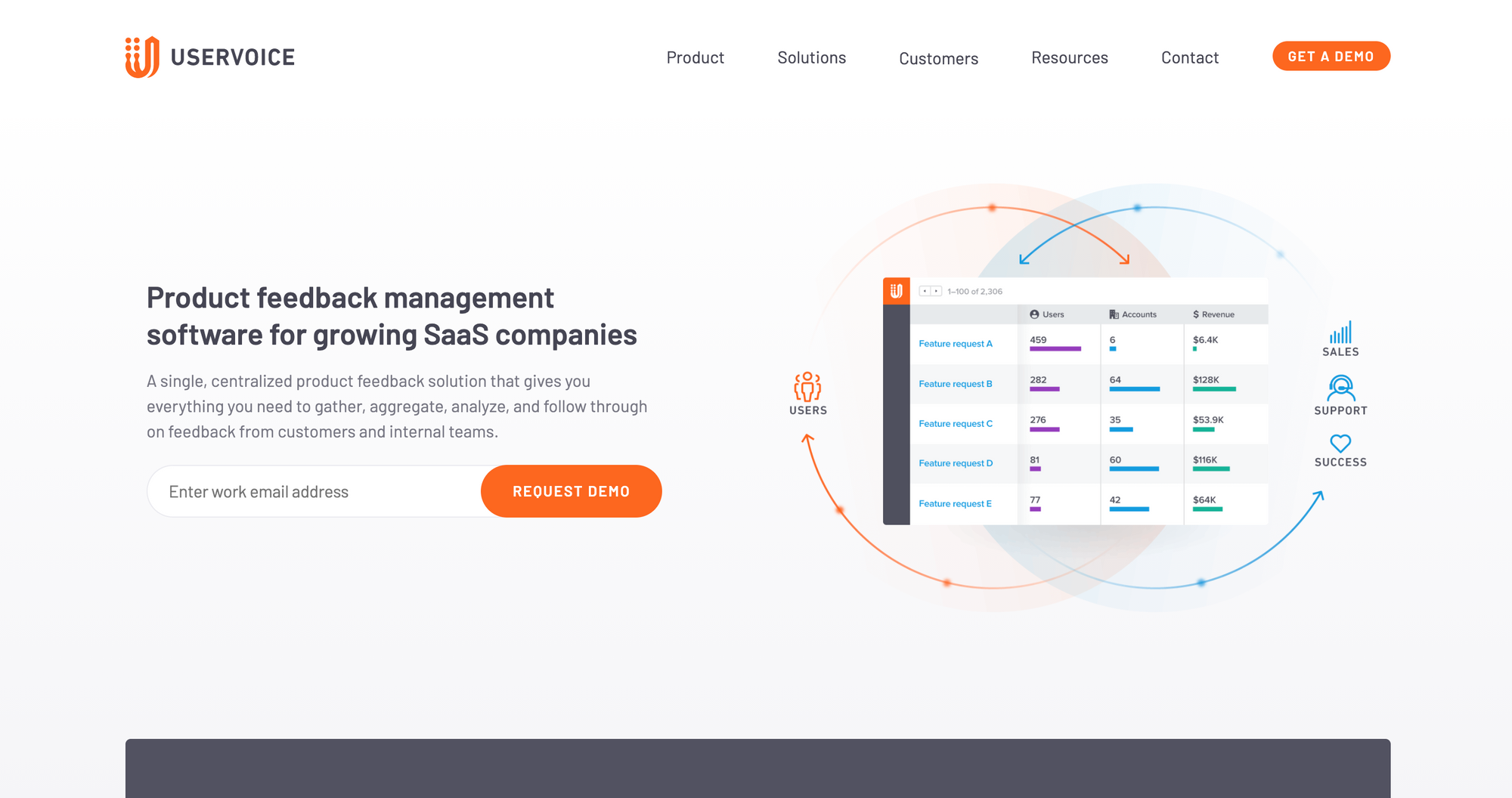
UserVoice was launched in California in 2008; the service is said to have many customers worldwide and caters to enterprise companies that want to gather customer feedback, process support requests, and increase customer satisfaction.
With UserVoice, companies can create feedback boards for customers to share their opinions with the company and rate various products or services.
Use Case: Best for product feedback management.
Pros of UserVoice
- UserVoice provides feedback software that gathers data from their customer base, analyzes it, and then presents it to them to make informed decisions about what should be improved or changed.
- UserVoice creates a feedback loop by providing forum software enabled with roadmap functionality.
- UserVoice has streamlined communication with customer-facing and product teams and keeps all product feedback in one location to increase transparency.
- They allow product teams to see how many customers requested a particular feature and its importance to their business goals. They allow segmentation and create cohorts for different types of users.
Cons of UserVoice
- UserVoice was built in 2008, and the user interface shows. It’s hard to navigate and has a steep learning curve.
- It is not a cheap option.
- Time-consuming and complicated onboarding requires much learning to understand the functionality, complete the setup, and collect user feedback.
Reviewers say that compared to Productboard, UserVoice is:
The good parts:
- Focused on feedback management.
- Trusted by companies like Microsoft.
The bad parts:
- Not Self-Serve
- More Expensive.
3. ProductPlan
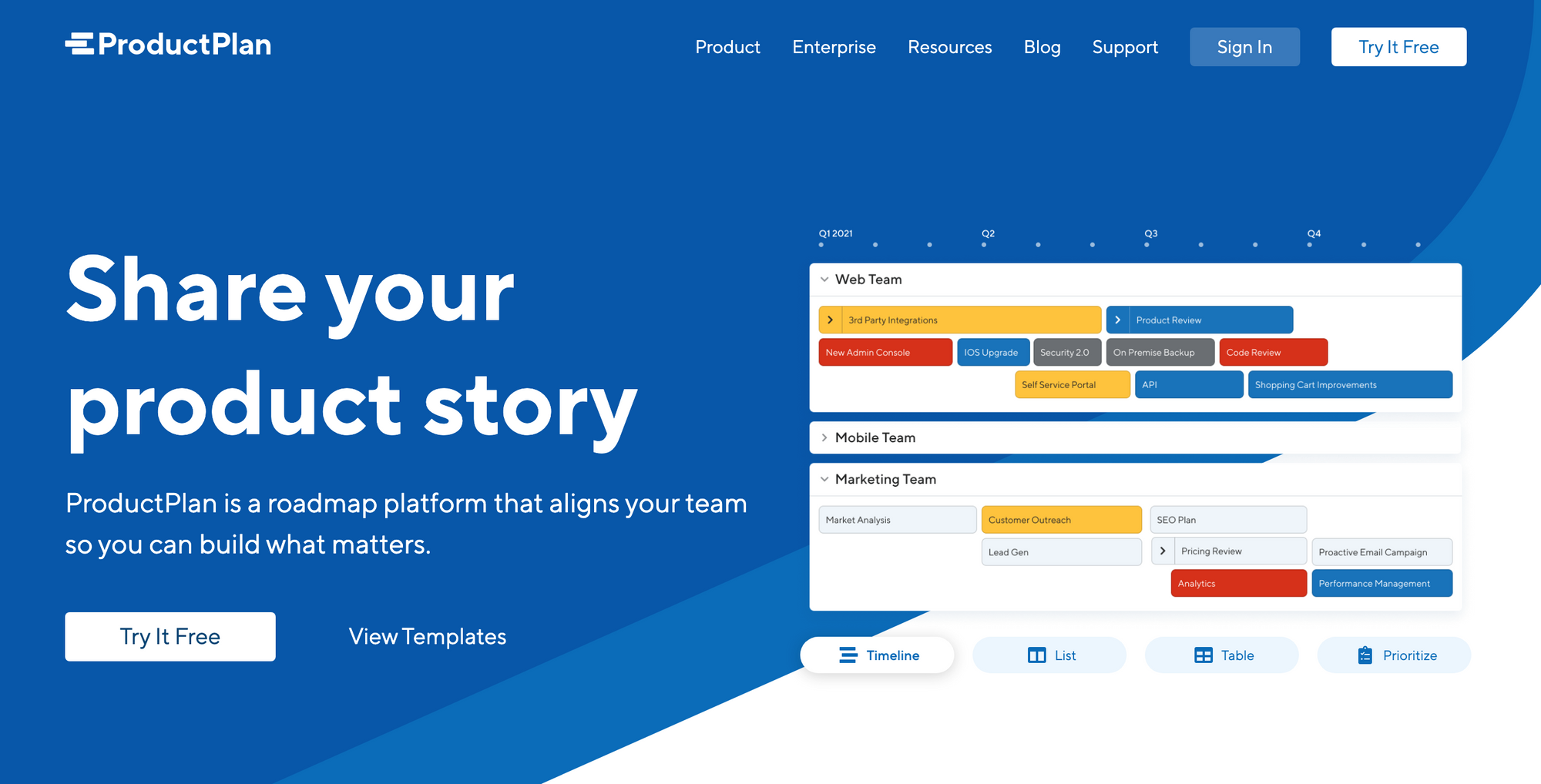
ProductPlan is an easy-to-use roadmapping software that helps teams plan, visualize, and share the product feedback strategy. Create beautiful, collaborative roadmaps in minutes.
Use Case: Best for product roadmapping.
Pros of ProductPlan
- ProductPlan supports quickly creating and updating roadmaps with a strong level of detail - the filtering capabilities also ensure we can share relevant roadmap details with the people who need them.
- One of their customers said," ProductPlan makes all work within the company more agile and simple, allowing working time to be more valued and without setbacks."
- It helps provide all stakeholders visibility into a company's development roadmap, knowing what is currently being worked on and what is coming up in the pipeline.
Cons of ProductPlan
- ProductPlan is a product management software first, not developed for feedback management, lacks product feedback boards, changelogs, and custom status, and requires extra payment for features like SSO.
- It accomplishes its core goal of visualizing a product roadmap, but it's hard to collaborate with teams, as not everyone has a paid account, so only one or two people can update the roadmap. Users can't comment and suggest changes as well as alternatives.
- The cost can be a little higher for small companies, limiting the use capacity for those who need it and can not afford a tool like this.
Reviewers say that compared to Productboard, ProducPlan is:
The good parts:
- Easier to set up
- More usable
- Better at meeting requirements
The bad parts:
- More expensive.
- Focused on roadmapping.
Looking for the best Productboard alternative? Check out Rapidr.io. Sign up now.
4. ProdPad
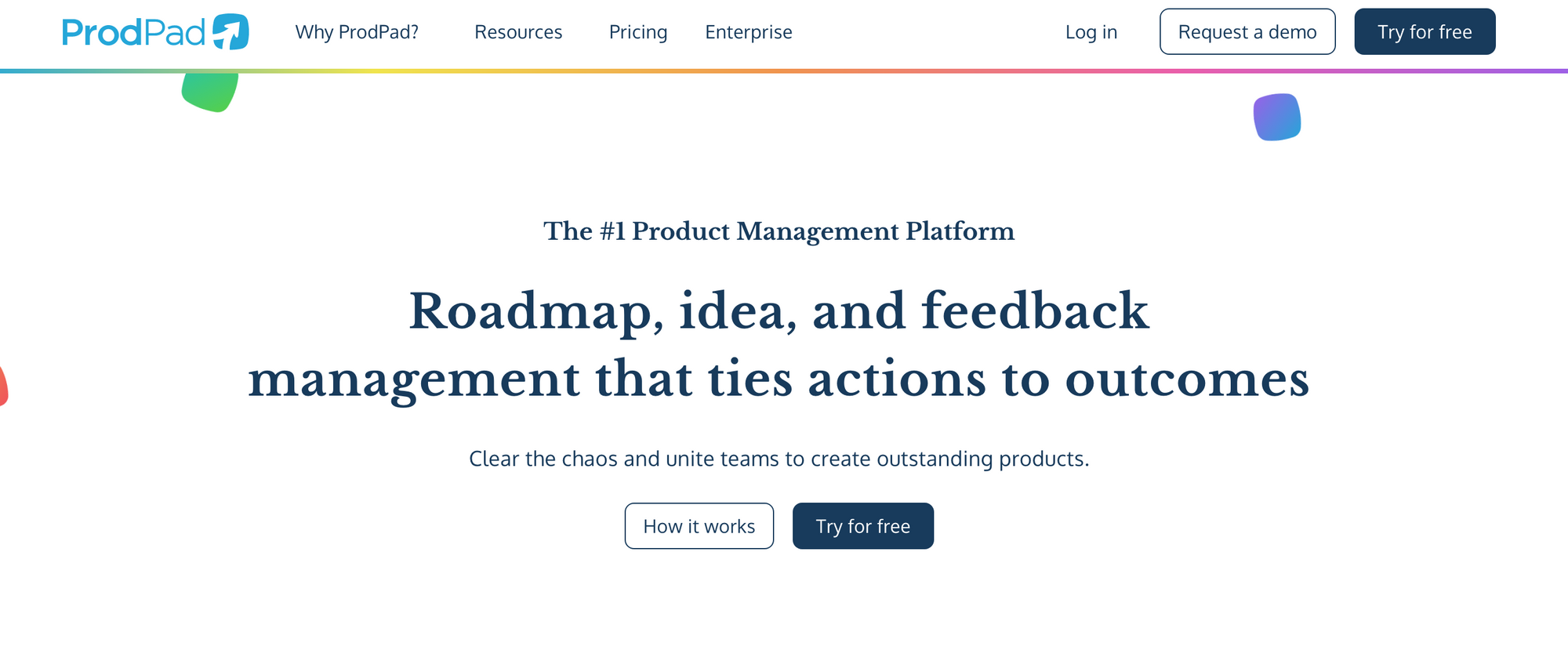
ProdPad is a product feedback and road-mapping tool where product teams can share feedback with other teams and customers about the product and upvote features with a feature voting board. It helps create a neatly structured roadmap for multiple products with a timeline view that showcases the updated announcements of a particular product.
Use case: Best for product feedback and roadmapping.
Pros of ProdPad
- The tool seems easy to use and supports the ability to build roadmaps to communicate with both engineers & executives at the same place.
- It also allows users to create multiple ideas and feedback that can be later used based on priorities. Users love the visualization charts inside the tool, which help teams prioritize projects better.
- Its interface has a reasonably intuitive design that allows me to perform multiple tasks and activities relatively quickly.
- ProdPad helps customers visualize, collaborate, and easily maintain their roadmaps in one place, replacing spreadsheets.
Cons of ProdPad
- Users complain that it's challenging to browse through different types of feedback and feature ideas in the software using search, and scanning through duplicates is also inconsistent with product updates. It needs external tools to utilize the client feedback feature entirely compared to its alternatives.
- ProdPad has a steep learning curve and can be overwhelming for new users.
- Their pricing model seems different as they don't charge per individual seat but on bundles of seats that work out to $50 per user.
Reviewers say that compared to Productboard, Prodpad is:
The good parts:
- Easy to use.
- Modern design.
- Easier to track quantitative feedback and product usage.
The bad parts:
- More expensive.
- Focused on analytics.
- Not self-serve.
Looking for the best Productboard alternative? Check out Rapidr.io. Sign up now.
5. Airfocus
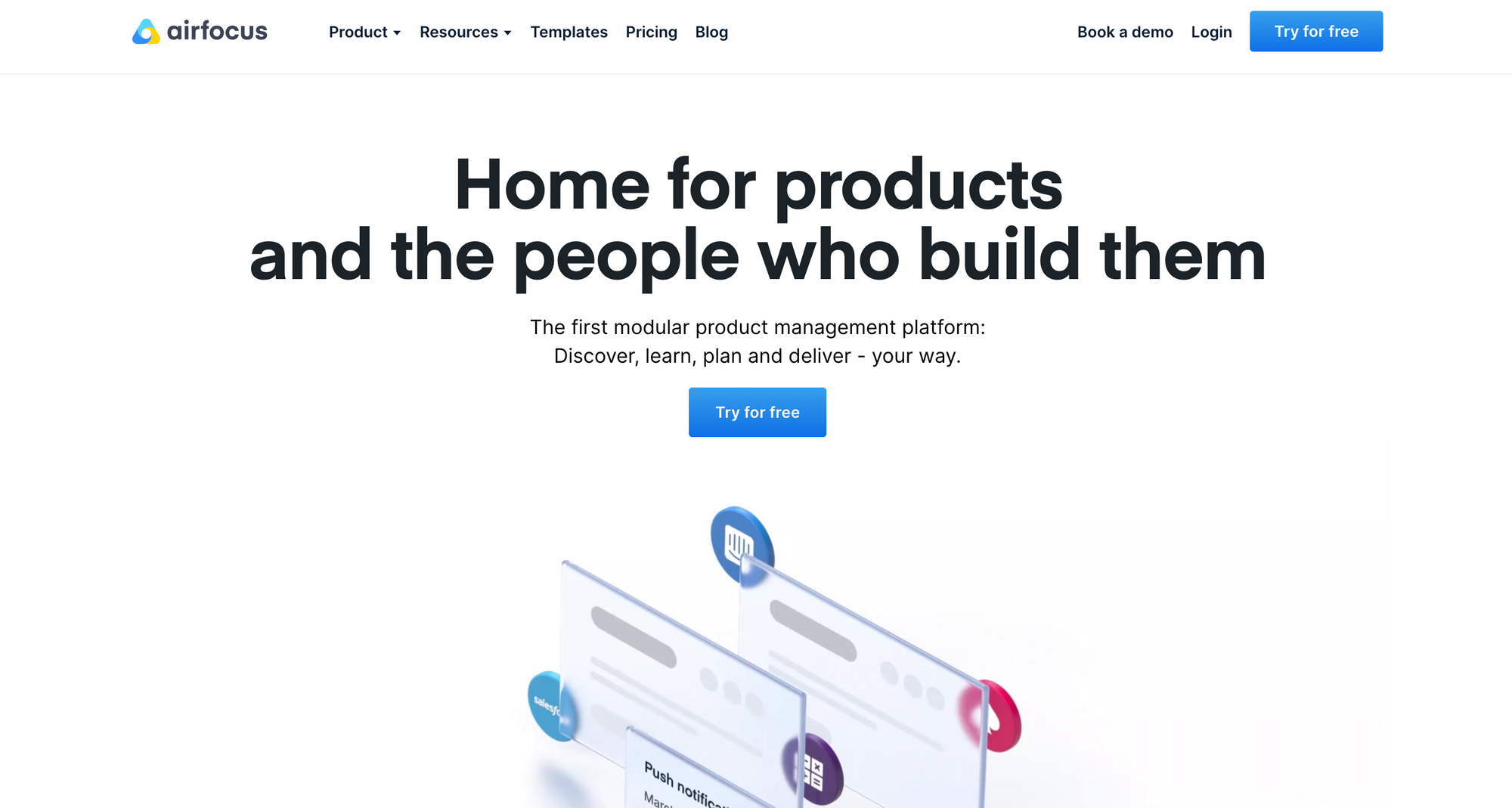
Airfocus offers a modern and modular project management platform. It provides a complete solution for teams to manage and communicate their strategy, prioritize their work, and solve the right problems.
Use case: Best for project management.
Pros of Airfocus
- Airfocus helps teams organize their project activities into sprints in the Kanban board, giving them a high-level overview of the Gantt Roadmap.
- It provides the flexibility and power of custom fields to define what is essential to product teams. Additionally, having a consolidated view of all products and building a complete public product roadmap of everything to show and discuss with stakeholders helps.
- Its chart view and timeline are easy to read and interpret. It helps teams present their overall product view to their stakeholders at the management level.
- It supports seamless integration with Trello, and synchronization works well between the two and can be used as a power-up for Trello.
Cons of Airfocus
- It's mainly a project management tool, not entirely focused on user feedback insights, and a pricey one. As a user said, " Paying a full "contributor" fee for inviting my local product users to organize one priority poker every three months is expensive."
- Tracing history versions or activities is challenging and requires manual fixing.
- It doesn't have an open feature voting for teams/customers or a public portal feature.
Reviewers say that compared to Productboard, Airfocus is:
The good parts:
- Integration with Trello.
- More usable.
- Easier to set up.
- Easier to do business with.
The bad parts:
- No support for open voting for teams and customers.
- More focused on project management.
6. Roadmunk
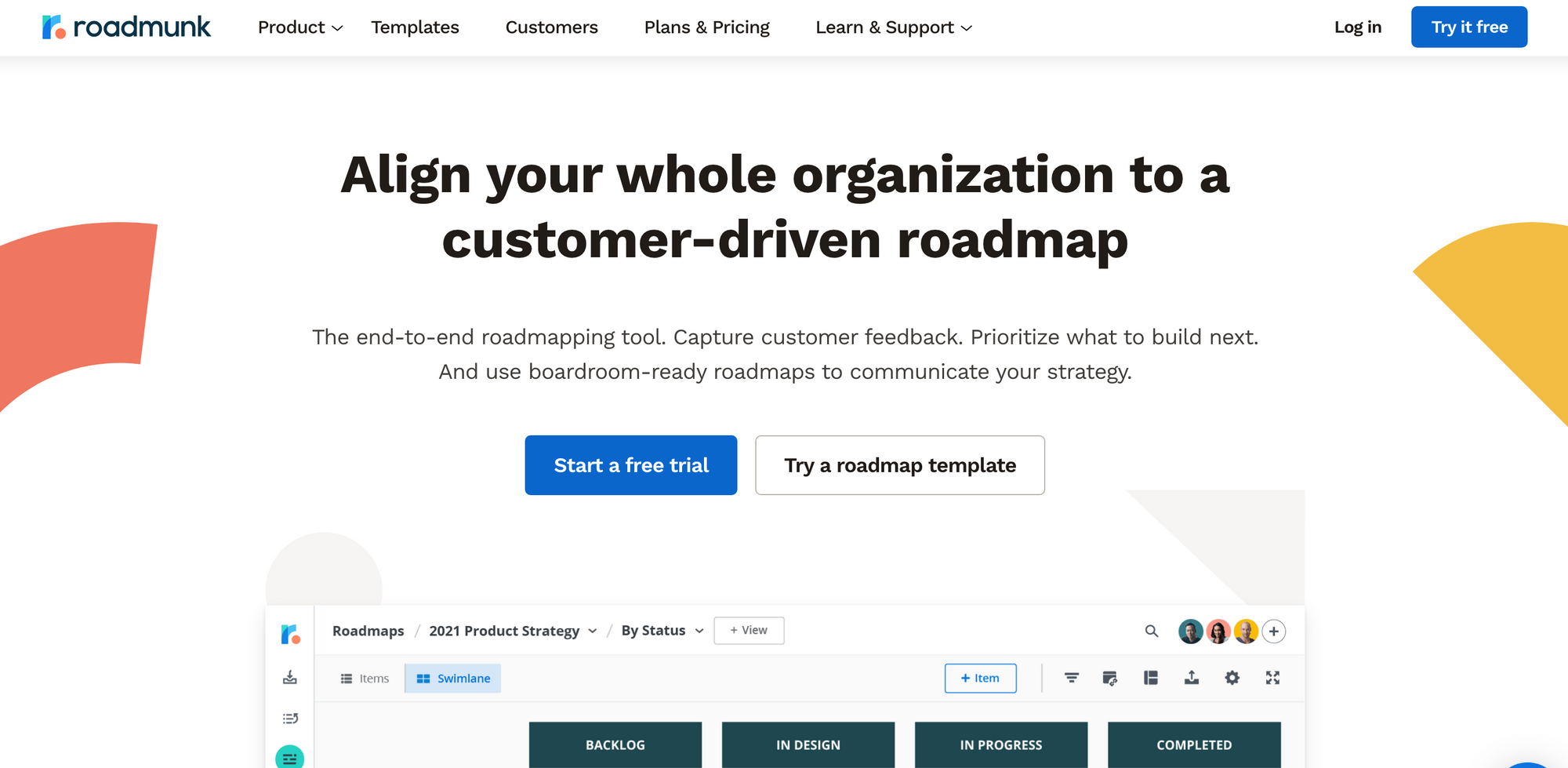
Roadmunk is a web-based product management platform that helps product managers plan and build customer-driven roadmaps across all organizations and industries. Roadmunk is an end-to-end management tool that creates customer-driven product roadmaps.
Use case: Best for product roadmapping.
Pros of Roadmunk
- The UI seems very clean and makes it easy for collaborators to look at the swim lanes or complete picture and know what they're looking at. This product perfectly shows complex timelines with multiple swimlanes, owners, and dependencies.
- The user experience and onboarding are brilliant, as quoted by its customers. This is simply the best planning software for small-to-medium technology companies.
- If you are looking for a product roadmap tool that provides excellent visuals but is limited in scope and does not require collaboration from several contributors, Roadmunk could do an adequate job for you.
Cons of Roadmunk
- Customers quote the tool to be expensive for small teams. Customers indicate the software is unclear on how you share, export your roadmap appropriately, and close the user feedback loop.
- The product does not scale well when multiple users collaborate on the same road map. Issues with the performance of the servers made the user experience cumbersome.
- If you're looking to work at an enterprise scale and collaboration on roadmaps is a reality in your organization, you may be better served looking at other products.
Reviewers say that compared to Productboard, Roadmunk is:
The good parts:
- Great user experience
- Modern design.
- Easier to maintain a product roadmap
The bad parts:
- Does not scale well.
- Focused on roadmapping.
- Not intuitive enough.
Looking for the best Productboard alternative? Check out Rapidr.io. Sign up now.
7. Asana
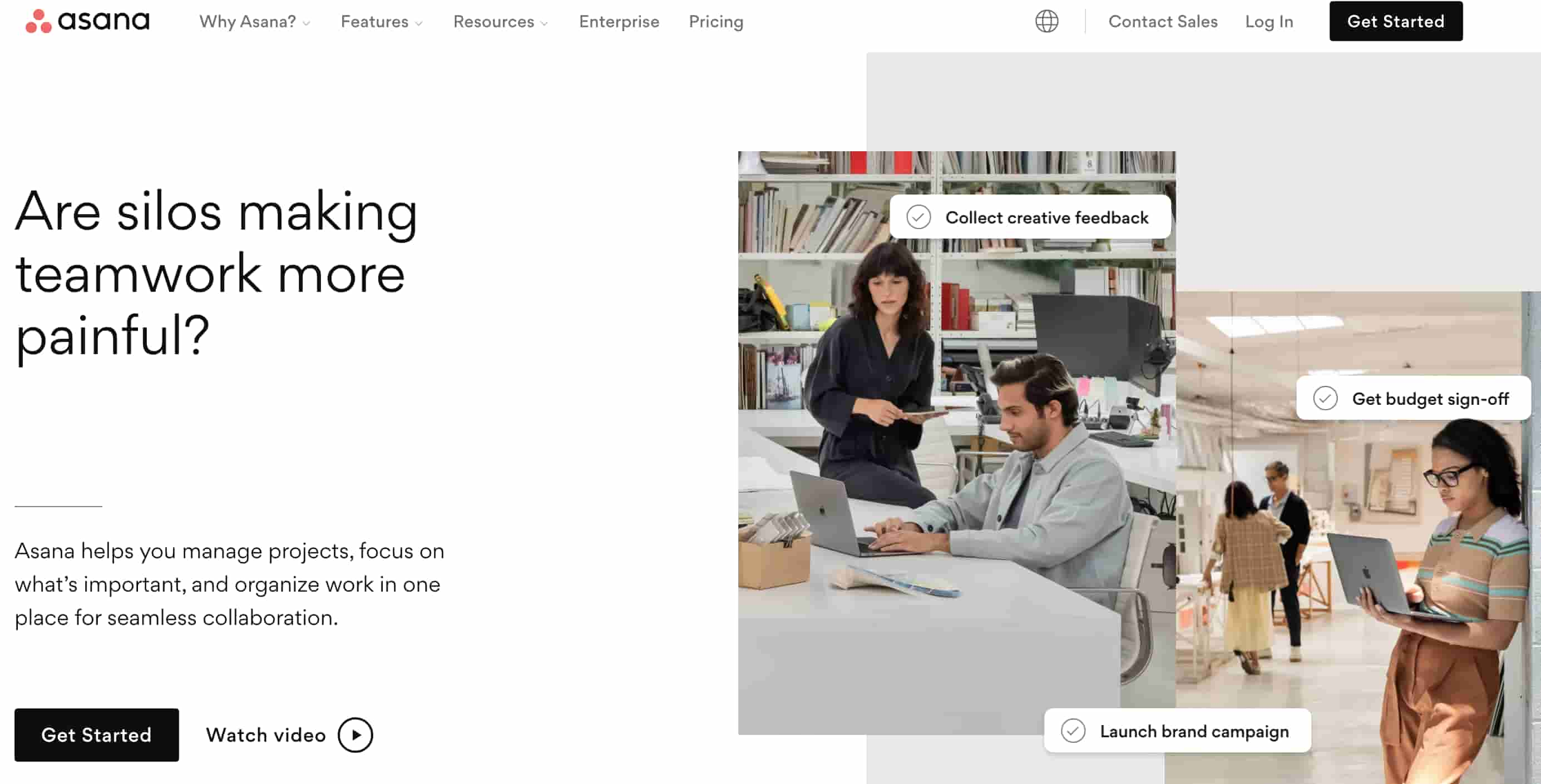
Asana is a task management and collaboration software that helps teams orchestrate their work, from daily tasks to strategic initiatives. In Asana, you can easily track initiatives' status and accurately view your progress toward goals.
Pricing: Offers a free trial. Paid plans start at $21 for five users per month.
Use Case: Best for task management and collaboration.
Pros of Asana
- Asana provides features and filters, making it easy for teams to ensure tasks are organized, on track, and going in the right direction.
- Product managers can manage projects and tasks collaboratively from anywhere, receiving notifications, sharing tasks, and efficiently monitoring them.
- Asana also compliments a massive list of integrations allowing teams to work directly with other tools without requiring additional input through exports.
Cons of Asana
- Automation in Asana is for enterprises only, and their pro/enterprise plan can be slightly more expensive for smaller companies.
- Customers claim it is not always easy to edit a project; staying in sync and keeping everyone on the same page in the tool is complex.
Reviewers say that compared to Productboard, Asana is:
The good parts:
- Simple to use.
- Supports integrations.
The bad parts:
- Lacks prominent features for feedback management.
- Lacks customer support.
8. Jira
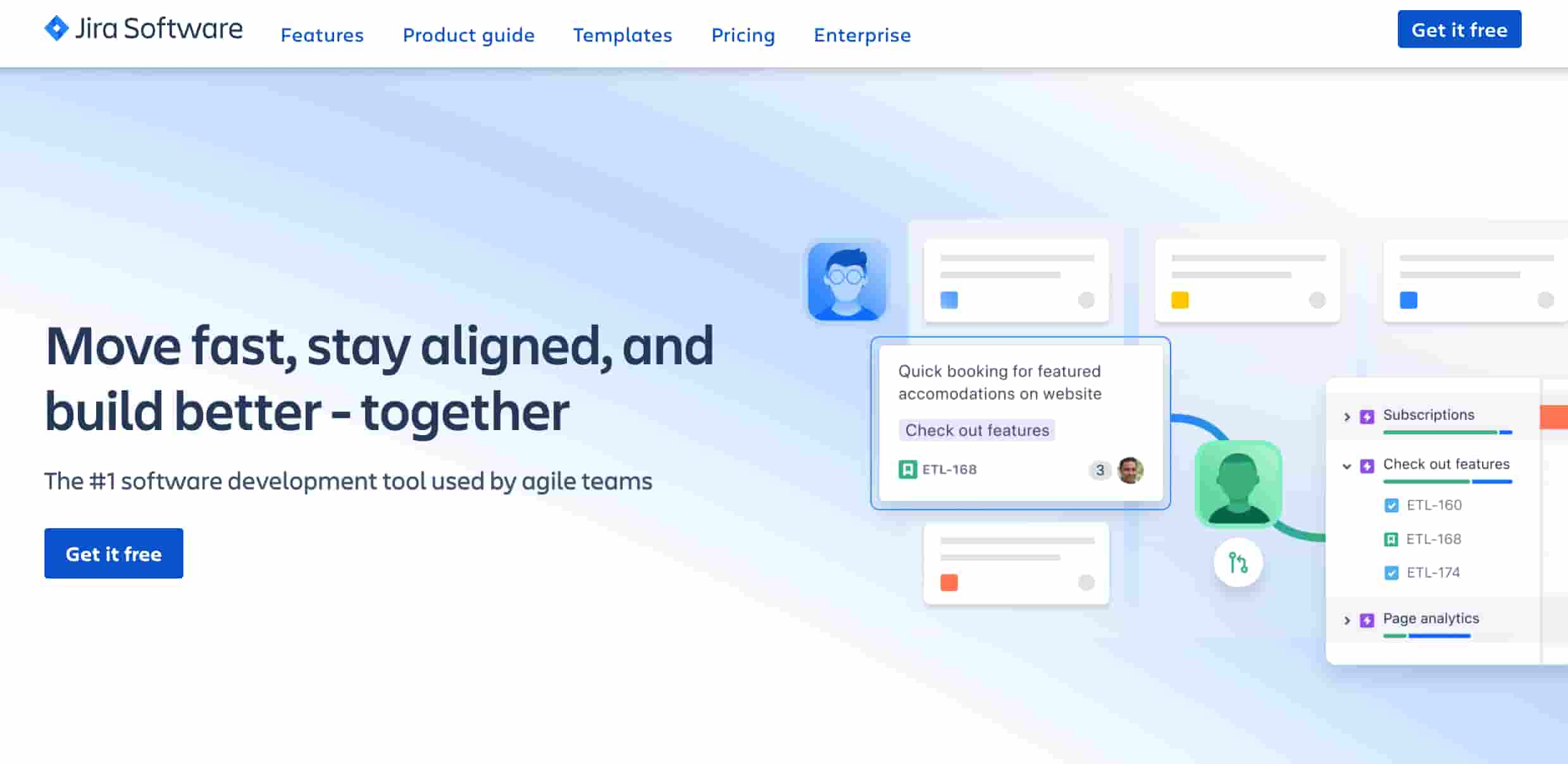
Jira helps teams to capture and organize issues, assign work, and follow team activity. It also helps track progress and performance with customizable reports and dashboards and supports various integrations such as Slack and GitHub. However, it can be quite complex to navigate and requires time and effort to set it up.
Pricing: Jira charges $7.50 per user per month.
Use Case: Best for issue tracking and project management.
Pros of Jira
- Jira is a project management tool that simplifies team collaboration by tracking progress, communicating updates, and assigning responsibilities among team members.
- Jira supports bug and milestone tracking, sprints, and agile product management in one tool but doesn't allow users to add feedback widgets on your website to track feedback directly.
- Jira also provides reports and analytics of the product development process.
Cons of Jira
- Jira started its life as an issue-tracking system. Its feedback management capabilities are lacking, and it shows.
- It lacks feedback portals, segmentation of feedback based on users, and feature prioritization filters to analyze and identify critical feedback. It also lacks the functionality to keep track of similar feedback and ways to categorize the feedback supported in Rapidr.
- Jira can be expensive, especially for organizations adding more add-ons and integrations.
Reviewers say that compared to Productboard, Jira is:
The good parts:
- Cost-effective.
- User-friendly interface
- Good support.
The bad parts:
- More focused on issue-tracking and management.
Looking for the best Productboard alternative? Check out Rapidr.io. Sign up now.
9. Craft.io
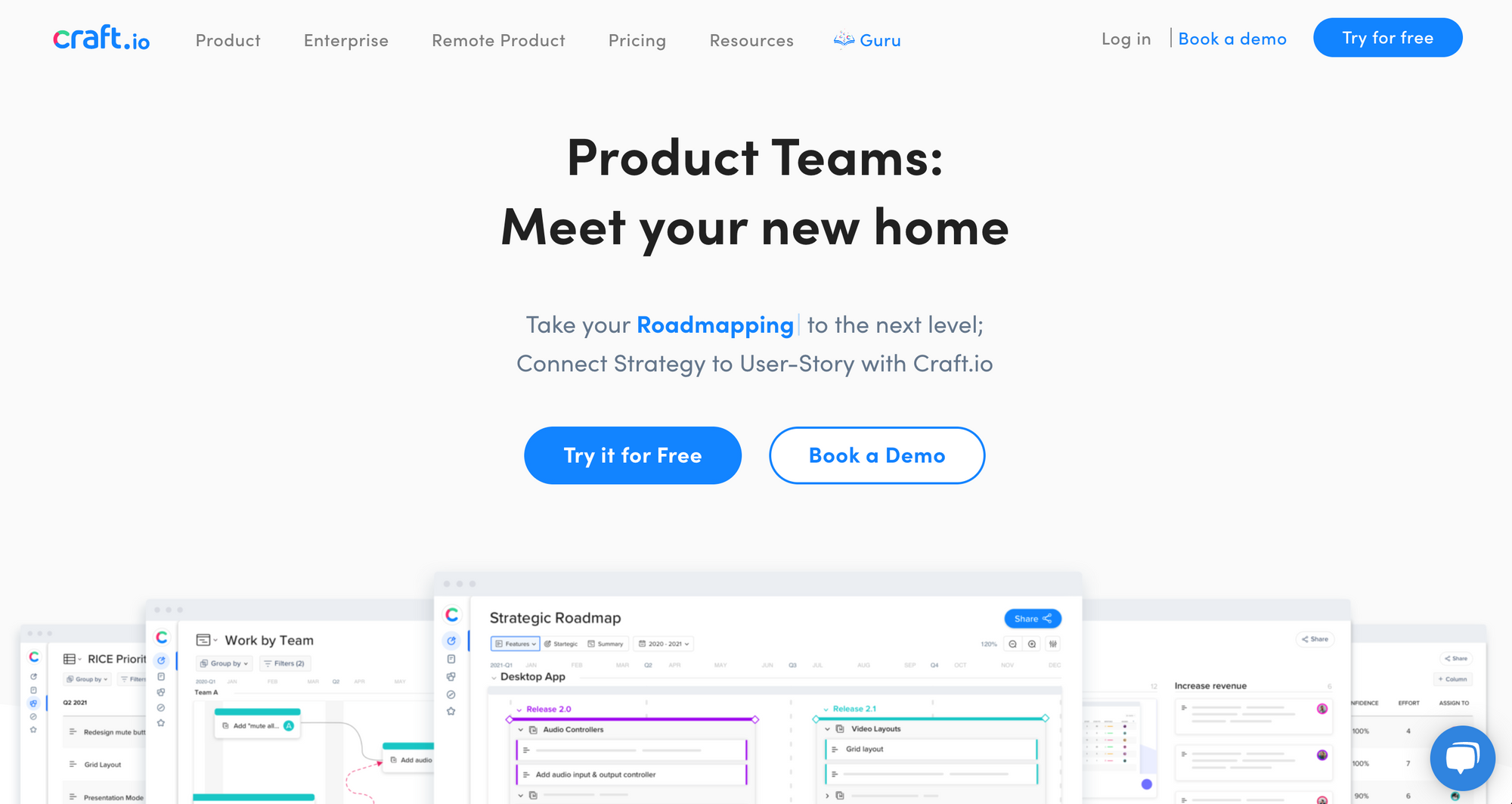
Craft is a product management tool empowering product managers to do their work from feedback capturing, planning, decision making, roadmapping, and more in one purpose-built tool that integrates with the most commonly used platforms.
Use case: Best for product management.
Pros of Craft
- Craft helps teams complete tasks, keep the deadlines game up high, and manage deadlines with a clear roadmap and workflow in the most organized manner ever.
- This tool ensures shared understanding with the entire team, arguably the most critical aspect of a successful product launch. It keeps everybody on the same page with a clear sprint backlog and milestones.
- Customers say it supports the entire product management life cycle with a rich, easy-to-use interface.
Cons of Craft
- It is expensive and isn't self-serve. It's frustrating to click around and figure out how to move from screen to screen in the app for users.
- It's not always easy to browse through, and finding items that haven't been appropriately tagged requires more effort than necessary.
- New users find it particularly difficult to navigate around craft unless given some training.
Reviewers say that compared to Productboard, Craft is:
The good parts:
- Better at support.
- Provides clear sprint backlog and milestones
- Rich and easy-to-use interface.
The bad parts:
- UI is difficult to navigate.
- More focused on product management
- Lack of essential features for feedback management.
10. ClickUp
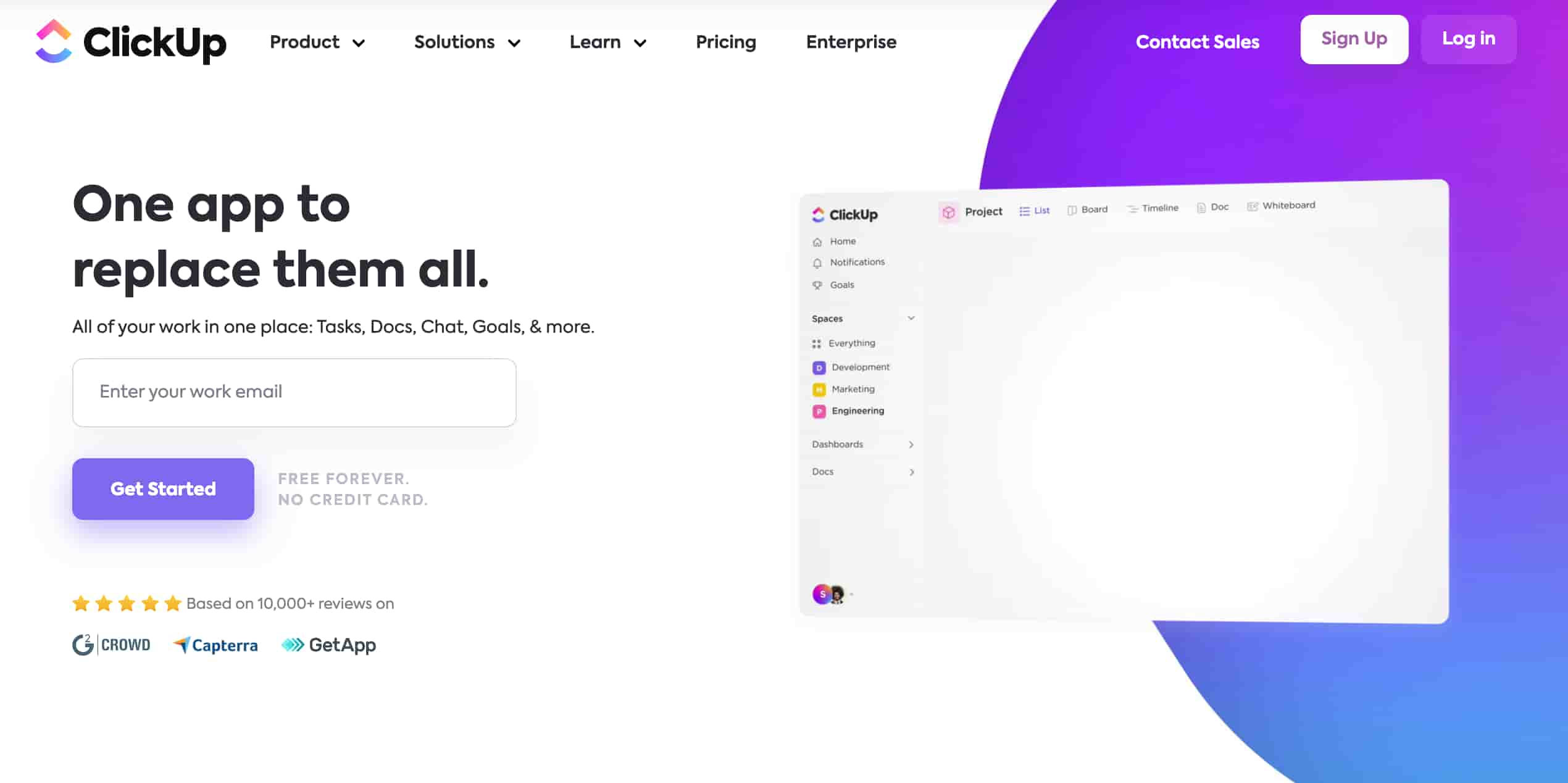
ClickUp provides powerful task management tools, including prioritization, assignment, and scheduling. It allows teams to collaborate in real time and offers a range of reporting options to help teams track their progress, measure performance, and identify areas for improvement.
Pricing: Offers a free plan with limited features and paid methods to start at $7/seat/month.
Use case: Best for product management.
Reviewers say that compared to Productboard, ClickUp is:
- The good parts:
- Easier to set up
- Provides reporting options
- Allows real-time collaboration
The bad parts:
- Majorly a task management tool.
- Lack of essential features to track quantitative feedback.
11. Monday.com
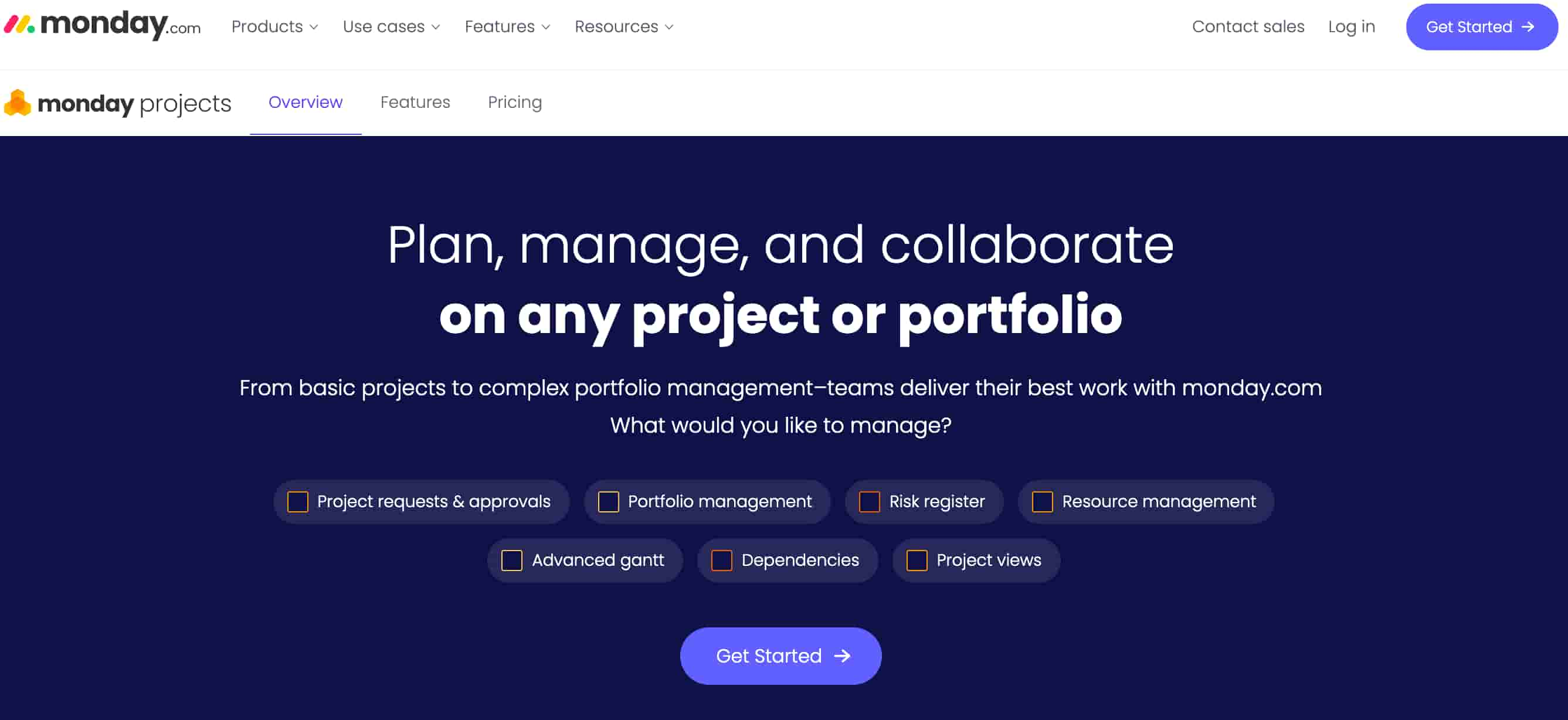
Monday is a project management and bug tracking tool that tracks all bugs in one place and provides a clear overview of bug statuses. It includes features to filter and prioritize bugs and create the right workflow for your team.
Pricing: Offers a free plan with limited features for up to two users and paid plans to start at $8/seat/month.
Use Case: Best for project management and bug tracking.
Pros of Monday.com
- It offers a range of features and tools for project management, task management, and team collaboration.
- Monday supports mind-mapping templates that connect different ideas and help teams visualize how they can complement each other.
- It integrates with other productivity tools such as Dropbox, Google Calendar, OneDrive, etc.
Cons of Monday.com
- It does not support dedicated feedback portals, in-app user feedback, and feedback segmentation.
- Monday.com is more expensive than other project management tools on the market.
Reviewers say that compared to Productboard, Monday.com is:
The good parts:
- Better at team collaboration.
- Provides bug-tracking tools.
- Easy-to-use interface.
The bad parts:
- More focused on bug and issue tracking.
- Lack of essential features for feedback management.
12. Pendo
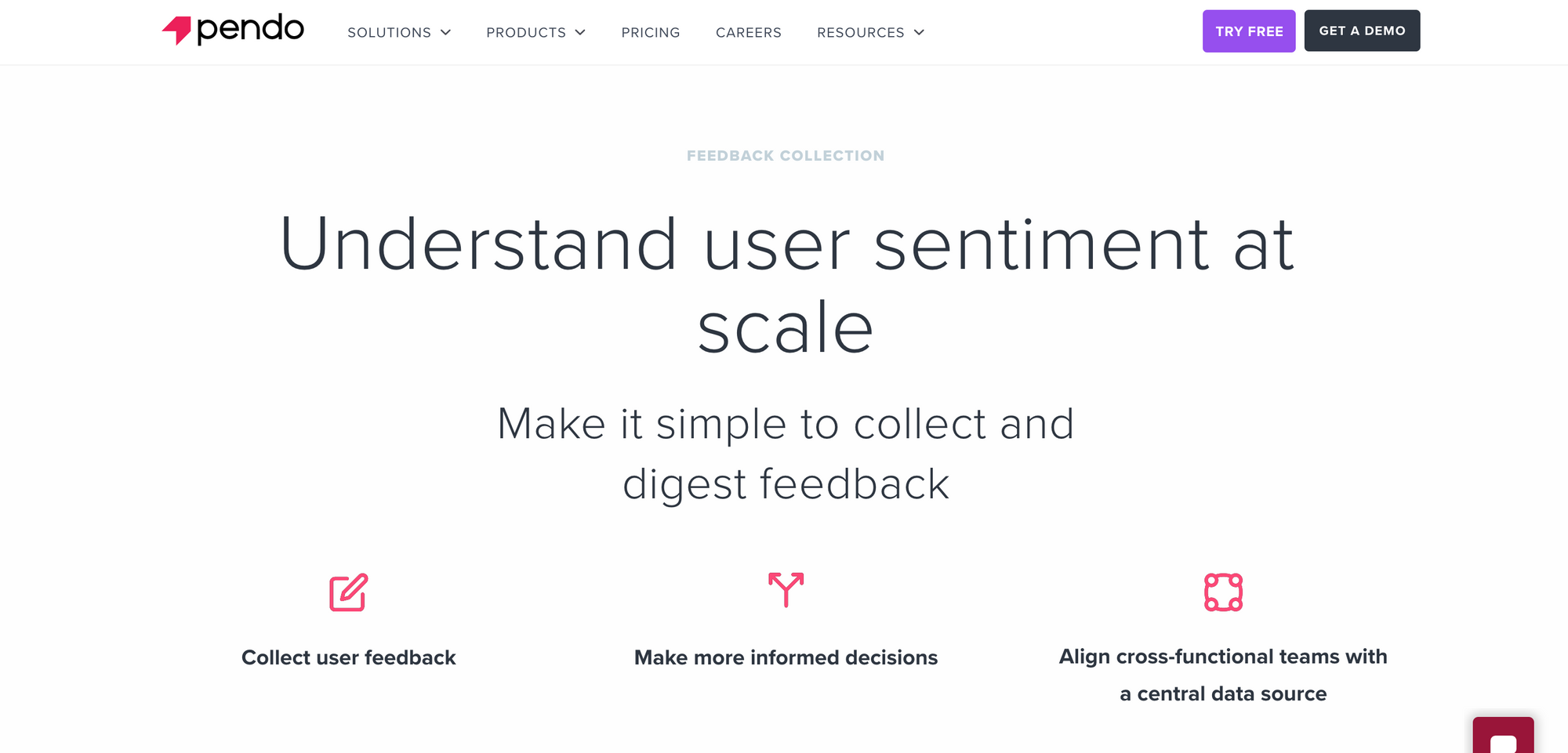
Pendo is an easy-to-use product analytics tool that provides insights into customer behaviors. Pendo Feedback helps collect customer requests directly in your application without interrupting the product experience. Internal teams can also create requests on behalf of customers and submit their internal product feedback.
Pendo Pricing: Contact for a custom quote. It is not self-serve.
Use case: Best for product analytics and user feedback.
Pros of Pendo
- Pendo is an easy-to-use product analytics tool that tracks users' activity to understand how users use the product and helps product managers make important product decisions, track feature adoption, and monitor user behavior.
- Pendo makes it easy to track product KPIs, track usage across the platform, and assign users to different groups to track segment usage over time.
- Pendo feedback helps create a direct line between users and the product team to simplify feedback aggregation. It’s a comprehensive solution for user onboarding, analytics, and in-app user feedback.
Cons of Pendo
- It is an analytics tool first, a feedback tool later, and it shows. There is a huge learning curve with it.
- Pendo's onboarding is lengthy and complex and only provides a few customization options without writing code or involving a developer.
- It is a pricey deal with Pendo. You need to contact a sales associate to get a custom plan and a price for your business, as they do not have pre-set pricing and are not self-serve.
Verdict: Rapidr is the Best Productboard Alternative
As a product manager, you must decide on a tool to make your product feedback management process a piece of the cake.
Each solution presented here is unique and has a different feature set, which caters to varying use cases that you can't go wrong with as an affordable alternative to Productboard.
We recommend Rapidr as the preferred Productboard alternative, which comes with a modern design, tightly nit feature set, clean user experience, and reasonable pricing plans. In addition, Rapidr offers a free 14-day trial. Sign up here.
FAQs
1. What are the top Productboard alternatives for product management?
Top Productboard Alternatives and Competitors for product managers are Rapidr, UserVoice, ProductPlan, Prodpad, Airfocus, Roadmunk, Asana, Jira, Craft.io, Clickup, Monday.com and Pendo.
2. Who is the #1 Productboard alternative?
Rapidr is the #1 Productboard alternative, which comes with a modern design, tightly nit feature set, clean user experience, and reasonable plans starting at $49/mo.
3. How does Productboard compare to Rapidr?
Rapidr is a modern and dedicated solution for customer feedback management tools that help product managers complete the user feedback lifecycle compared to Productboard. This complex project management tool is not dedicated to customer feedback.
Rapidr is an end-to-end feedback solution, so you don't have to glue multiple apps together. You get feedback collection, roadmapping, and release notes software with it. Get started now.

